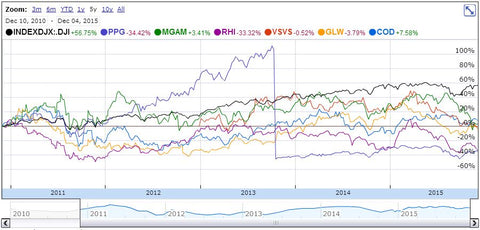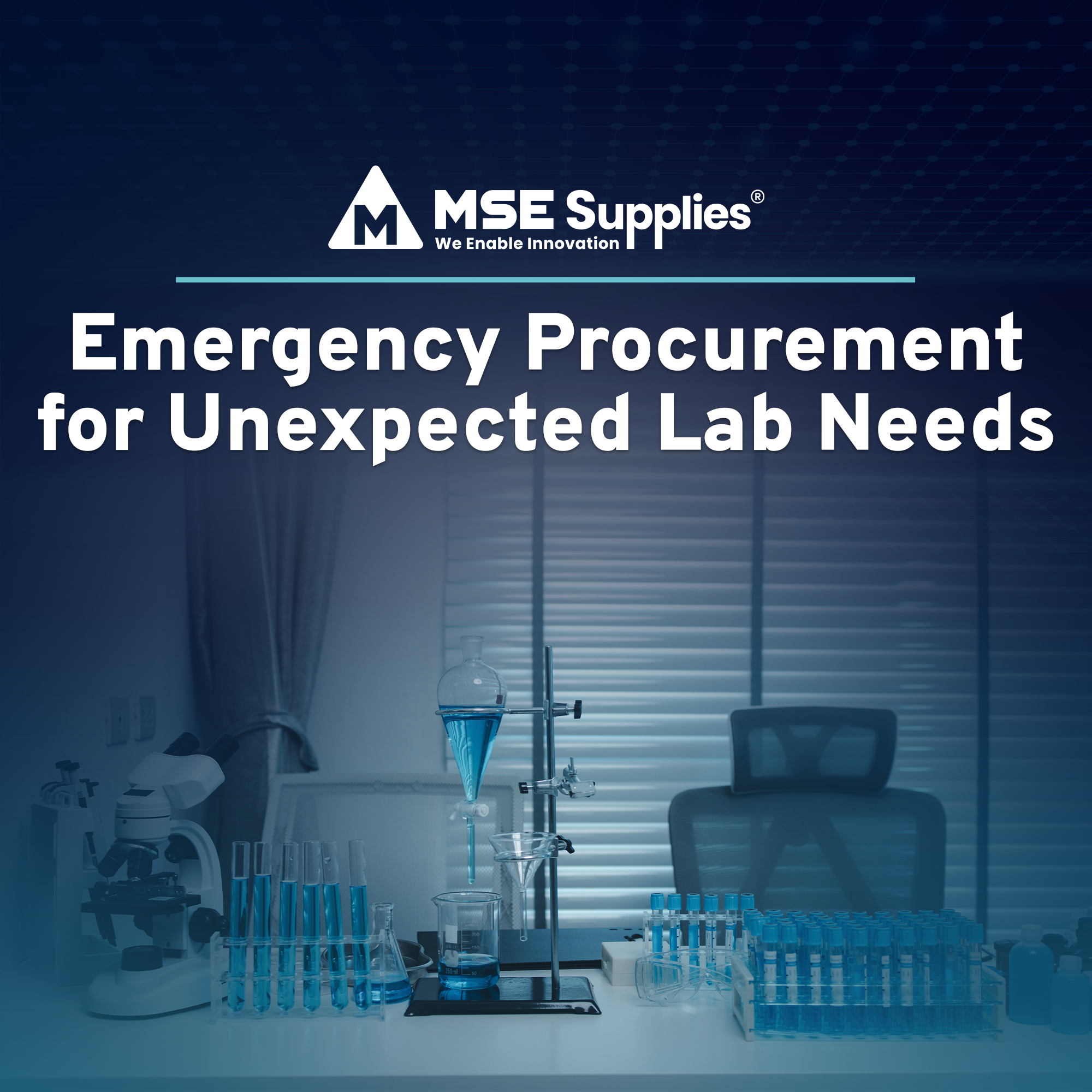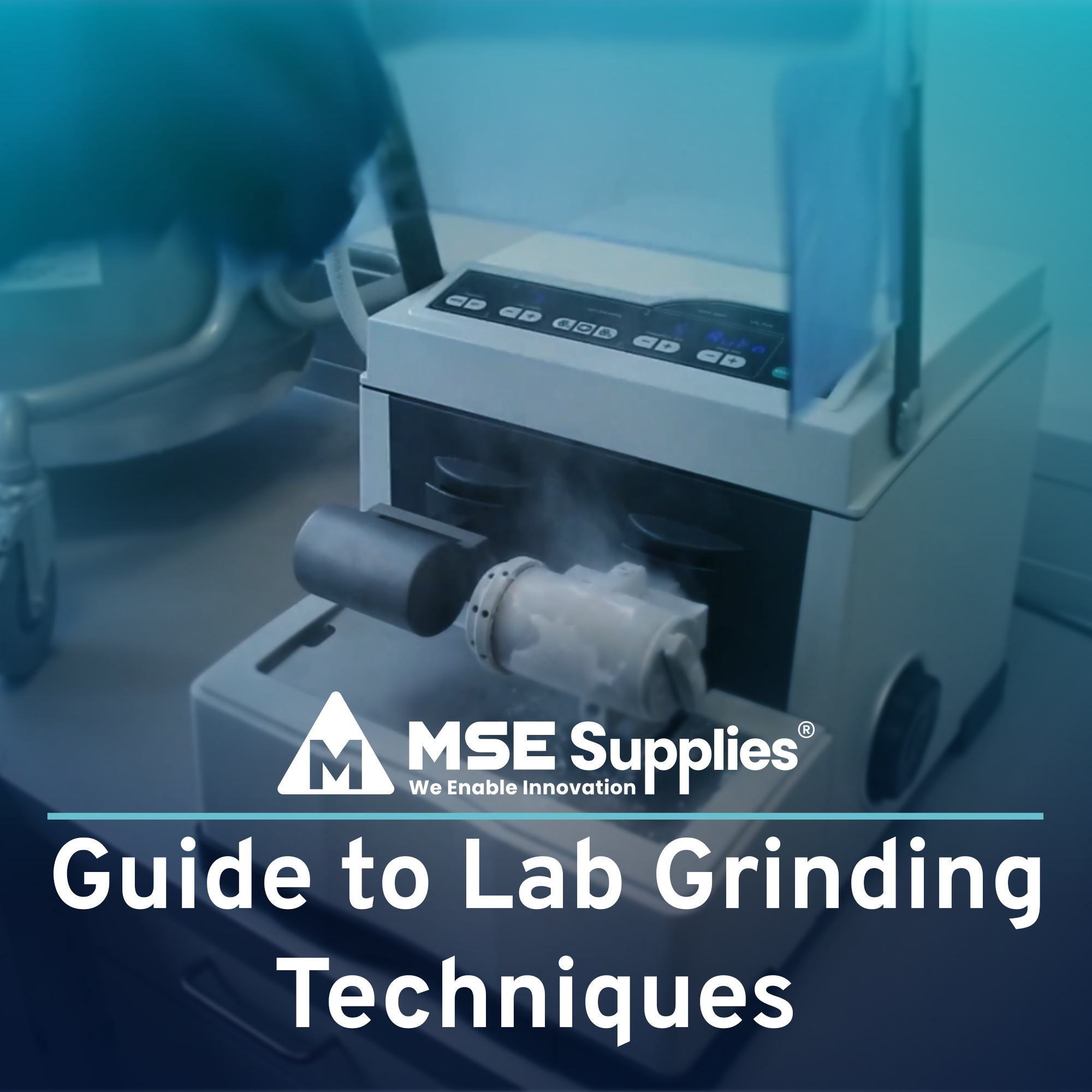2015 Ranking: Top 12 Leading Global Companies of Advanced Ceramics, Glasses and Refractories
Posted by MSE Supplies on
Ceramic Industry magazine recently published its third annual ranking of the leading worldwide manufacturers of advanced ceramics, glasses and refractories! Factors that were used for the ranking include annual revenues and number of employees, as well as views on the company’s past performance and future outlook.
The data were compiled from both surveys and the information from company websites, annual reports, press releases, etc. in order to develop the rankings.
msesupplies.com also looked at the performance of these companies' share prices over the last five years. Compared to the benchmark Dow Jones Industrial Index, all these companies shown on the following chart under-performed. Even highly innovative companies such as Corning (GLW) had a disappointing performance of -3.79% over the last five years.
1. Saint-Gobain
Tour Les Miroirs, 18 Avenue d’Alsace
92 096 La Défense Cedex, France
www.saint-gobain.com
CEO: Pierre-André de Chalendar
Saint-Gobain is a global designer, producer and distributor of a variety of high-performance and construction materials, ranging from photovoltaic glass to industrial ceramic components and more. The group achieved total net sales (for all business segments) of €41.1 (approximately $45.5 billion) in 2014, essentially flat compared to the prior year. The group spent €400 million (~ $436.3 million) on R&D in 2014. With 3,700 employees focused on R&D at seven sites around the world, Saint-Gobain filed more than 350 patents in 2014.
Saint-Gobain’s Innovative Materials segment, which has nearly 59,000 employees in over 500 sites around the world, represented 22% of total net sales in 2014 and produces products such as flat glass, abrasives, ceramics, and refractories. According to the company, “Through its innovation potential, its network of application engineers and its expertise in materials transformation processes, Saint-Gobain offers solutions specifically tailored to the dynamic automotive, aerospace, health and energy markets, developed in close collaboration with its customers.”
Saint-Gobain achieved an impressive milestone in 2015, reaching its 350th anniversary. The group celebrated with travelling pavilions that visited four major cities around the world, an online exhibition and a book entitled Saint-Gobain 1665-2015: The History of the Future. (To learn more about the group’s history, read “350 Years of Achievements” in our August 2015 issue.)
“Our history is proof that we are a company that has consistently pushed back boundaries and taken up technological challenges,” said Pierre-André de Chalendar, chairman and CEO. “As we look back over our past and examine today’s world and what we do, we are convinced that there are many reasons to believe in the future. So it is with our sights set on the future and innovation that we are celebrating this anniversary.”
Source: company website, press releases
2. Corning Inc.
One Riverfront Plaza, Corning, NY 14831
www.corning.com
CEO: Wendell P. Weeks
Corning employs nearly 35,000 people worldwide. Research centers are located in North America, Europe and Asia; as a percentage of net sales, R&D spending was 8% in 2014, reaching $815 million. Corning received approximately 400 U.S. patents in 2014, as well as more than 750 patents throughout the rest of the world. According to the company, “We continue to focus on new product development in areas such as glass substrates for high-performance displays in our Display Technologies segment, wireless solutions for diverse venue applications in the Optical Communications segment, and advancement of new product attributes for our Corning® Gorilla® glass suite of products in our Specialty Materials segment.”
Segments include Display Technologies (glass substrates for flat panel displays and LCDs), Environmental Technologies (ceramics substrates and filters for cars and trucks), and Specialty Materials (formulations for glass, glass ceramics and fluoride crystals), among others. Net sales for all segments increased in 2014, including: Display Technologies, up by $1.3 billion; Environmental Technologies, by $173 million; and Specialty Materials, by $35 million. Corning achieved total net sales of $9.7 billion in 2014, an increase of 24% compared to the prior year.
Over the past year, Corning made several key acquisitions, including TR Manufacturing, Inc.; Samsung Electronics Co., Ltd.’s fiber optics business; iBwave Solutions, Inc.; and the pharmaceutical glass tubing business of Gerresheimer AG. The company also announced several new technologies, including Iris™ Glass, which can reportedly reduce the thickness of a liquid crystal display (LCD) TV set, and Corning Gorilla Glass 4, which is reportedly up to two times tougher than any competitive cover glass design on the market.
Sources: company website, annual report, press releases
3. AGC Group
1-5-1, Marunouchi, Chiyoda-ku
Tokyo 100-8405, Japan
www.agc.com
CEO: Kazuhiko Ishimura
The AGC Group is comprised of over 190 consolidated subsidiaries and has more than 51,000 employees in about 30 countries/regions around the world. AGC’s total net sales for 2014 were ¥1,348 billion (~ $10.9 billion), representing an increase of 2.1% vs. 2013.
The group operates in four main segments: Glass (53% of sales), which produces products such as float, low-e and automotive glasses; Electronics (22%), including glass substrates for various electronics applications, synthetic quartz glass, and glass frit/paste; Ceramics/Other (2%), which produces refractory materials, fine ceramics and sputtering targets; and Chemicals (23%).
In September 2014, AGC announced it would invest ¥16 billion (~ $149 million) in subsidiary company PT Asahimas Flat Glass Tbk to set up a state-of-the-art float glass furnace in Jakarta, Indonesia. Mass production of float glass for architectural and automotive applications is expected by the third quarter of 2016.
AGC announced in April of this year that it planned to increase production capacity of solar control low-e glass in Thailand by 50% in order to meet increasing demand from the construction industry in Southeast Asia. AGC Flat Glass Thailand Public Co., Ltd.’s Samut Prakan Plant is expected to begin this increased production in the first quarter of next year. Also in April, AGC announced that it would build a furnace for TFT-LCD glass substrates in Huizhou, Guangdong Province, China. Demand for TFT-LCD panels continues to be strong for use in TVs, mobile devices and IT applications. For this project, AGC plans to transplant production facilities from Japan in order to achieve a significant reduction in capital investment. Operation is expected to begin at the end of 2016 or early 2017.
Source: company website, annual report, press releases
4. Murata Manufacturing Co., Ltd.
10-1, Higashikotari 1-chome, Nagaokakyo-shi Kyoto 617-8555, Japan
www.murata.com
CEO: Tsuneo Murata
Murata specializes in the manufacture of technical ceramic components for electronics applications. Its nearly 52,000 worldwide employees produce products such as multilayer ceramic capacitors (MLCCs) and piezoelectric ceramic components, among others. Total net sales for the 2015 fiscal year (ended March 31, 2015) reached ¥1,040 billion (~ $8.4 billion), an increase of over 23% compared to the prior fiscal year.
Last December, Murata Electronics North America, Inc. (a full subsidiary) acquired Peregrine Semiconductor Corp., one of the main suppliers for Murata’s radio frequency (RF) front-end modules. As a result of the acquisition, Murata expected to establish an integrated development system that encompasses all aspects from RF component semiconductor process development to semiconductor design, circuit design, and module design.
Murata was one of 11 companies to receive Intel Corp.’s Supplier Continuous Quality Improvement (SCQI) award for its performance in 2014. Murata provided MLCCs, inductors and electromagnetic interference components, SAW filters, and RF modules that were reportedly deemed essential to Intel’s success.
“Murata has consistently worked to help us meet our technology development and affordability challenges throughout 2014,” said Mostafa Aghazadeh, Intel’s vice president for Chandler Assembly Technology Development. “They have consistently demonstrated a willingness to partner with Intel on next-generation products and platforms…”
Sources: company website, annual report, press releases
5. The NSG Group
Sumitomo Fudosan Mita Twin Building
West Wing, 5-27, Mita 3-Chrome
Minato-ku, Tokyo 108-6321, Japan
www.nsg.com
CEO: Shigeki Mori
The NSG Group operates with 27,000 employees in 28 countries and serves customers in more than 130 countries. With total revenue of ¥626.7 billion (~ $5.2 billion) in its 2015 fiscal year (ended March 31, 2015), NSG produces high-performance glass and glazing solutions in three business areas: Architectural and Building Products (40% of sales), producing products such as solar control glass, self-cleaning glass, and glass for solar applications; Automotive (50%); and Technical Glass (10%), which manufactures products like LCD glass and glass cord. The group spent ¥8.2 billion (~ $66 million) on R&D for the fiscal year.
Operating results in the Architectural business improved over the prior fiscal year due to cost savings that resulted from the group’s restructuring program, as well as improved market conditions in North America. Revenues in the Automotive segment improved slightly, due mainly to the weaker Japanese yen, but profits dipped due to challenging market conditions. The Technical Glass business experienced a decline in revenue due, in part, to reduced pricing for certain products. Increased competition also negatively affected revenues from thin glass for displays.
Source: company website, annual report, press releases
6. Kyocera Corp.
6 Takeda Tobadono-cho, Fishimu-ku
Kyoto 612-8501, Japan
www.kyocera.com
Chairman: Tetsuo Kuba
Kyocera employs approximately 70,000 people via 226 worldwide group companies. Consolidated net sales for the fiscal year ended March 31, 2015, reached ¥1,527 billion (~ $12.7 billion), an increase of 5.5% over the 2014 fiscal year. According to Elly Yoshikawa, Kyocera’s deputy manager of Corporate Communications, Kyocera achieved advanced ceramics/glass-related revenue of $2.1 billion for the 2015 fiscal year. (This figure represents total revenue in the company’s Fine Ceramics and Semiconductor Parts segments, with revenue from certain non-ceramic products subtracted.) Individually, total revenue within the company’s consolidated Fine Ceramics segment increased 13.3%, and total revenue within the consolidated Semiconductor Parts segment increased 16% for the year.
In the industrial machinery market, Kyocera is strengthening the development of parts for next-generation semiconductor fabrication equipment, which includes equipment for next-generation, larger-dimension silicon wafers. In the automotive market, the company is working to develop camera modules for rearview detection and collision prevention, an area where demand is forecast to increase due to new safety regulations. At the same time, Kyocera is concentrating development on ceramic parts for diesel engines that contribute to a reduction of carbon dioxide and other exhaust gas emissions.
In the environment and energy market, Kyocera is strengthening its development of solid oxide fuel cell (SOFC) systems and components, which hold great potential as new energy supply systems for a low-carbon society; and LED-related products, where demand is growing in lighting applications.
In the digital consumer equipment market, needs continue to grow for products such as smartphones and tablet computers that are more multifunctional, as well as smaller and thinner. In line with this trend, electronic components used in such equipment are getting smaller, while semiconductors are becoming more highly integrated. In the information and communications network market, demand is rising for faster, higher-capacity infrastructure. To expand its business in response to these market trends, Kyocera is working to develop new high-value-added products that leverage its material, design and layering technologies. Specifically, in the ceramic package business, the company is working on the development of high-strength, high-rigidity, ultra-small and thin ceramic packages that employ micro-wiring, as well as ceramic packages for optical communications that can support higher-frequency operation.
Kyocera’s financial forecast for the fiscal year ending March 31, 2016, calls for total consolidated revenue to increase 4.8%. (This forecast includes all business segments, both ceramic and non-ceramic. Separate forecasts for individual business segments are not available.)
Sources: company contact, company website, press releases
7. SCHOTT AG
Hattenbergstrasse 10, 55122 Mainz, Germany
www.schott.com
Chairman of the Management Board: Frank Heinricht
SCHOTT’s workforce of over 15,400 employees provides customers around the world with specialty glass and glass-ceramics products. The group’s materials and advanced technologies serve the architecture, pharmaceutical, electronics, transportation and optics industries, producing total sales in the 2013/2014 fiscal year (October 1, 2013-September 30, 2014) of nearly €1.9 billion (~ $2.1 billion). For the 2013/2014 fiscal year, SCHOTT’s spending on R&D reached €86 million (~ $94.2 million), or 4.6% of group sales.
Last November, SCHOTT announced that it would move and centralize a portion of its optical glass production from its Duryea, Pa., plant to its headquarters in Mainz. The move impacted select optical glass production in the Advanced Optics Division. The site’s non-continuous melting operations, its role as the division’s North American customer service hub, and its North America Research & Development Center were not affected.
Source: company website, annual report, press releases
8. Vesuvius plc
165 Fleet St., London EC4A 2AE, England
www.vesuvius.com
CEO: FranÇois Wanecq
Vesuvius, which specializes in steel flow control, foundry technologies and advanced refractories for a range of end markets, employs nearly 12,000 individuals working in 38 countries around the world. Achieving total revenue of £1.4 billion (~ $2.4 billion) in 2014, the group has 65 production sites, 84 sales offices and 16 R&D centers.
Vesuvius spent £26.1 million (~ $40.5 million), or 1.8% of its revenue, on R&D in 2014. In December, the group opened a new Global Foundry R&D Centre in Enschede, Netherlands, which will coordinate the R&D activities of other centers located in Pittsburgh, Pa., Feignes, France, and Tamworth, UK. Vesuvius is also creating a state-of-the-art global center of excellence for steelmaking and foundry refractories in Pittsburgh, and is planning an Advanced Refractories center of excellence in Visakhapatnam, India.
Source: industry source, company website, annual report
9. CoorsTek, Inc.
16000 Table Mountain Pkwy., Golden, CO 80403
www.coorstek.com
CEO: John K. Coors
With 50 facilities located in 14 countries, CoorsTek’s workforce of 6,000 is spread across four continents. The company produces hundreds of technical ceramic products for applications in aerospace and defense; semiconductor; oil and gas; automotive; household durables; and heavy industries such as rail, energy, and mining.
In January of this year, CoorsTek finalized its acquisition of Covalent Materials, a leading Japanese engineered ceramics manufacturer. The acquisition provided substantially expanded access to Japanese and other key Asian markets, complementing CoorsTek’s existing Japanese and South Korean operations, as well as its North American, European and South American presence. CoorsTek and Covalent serve over 10,000 technology and manufacturing customers across all major industrial markets. The semiconductor industry is a key market to the newly expanded CoorsTek. The Covalent facilities are now a part of the CoorsTek Semiconductor and Medical group.
In addition, the company acquired the assets of BLS Textiles, Inc. of Cambridge, Ontario, in June and integrated the production equipment, technology, and existing contracts into its DEW Engineering & Development ULC (DEW) subsidiary. DEW is reportedly a well-established leader in military vehicle armor up-fitting, design, manufacturing and integration. The acquisition extended DEW and CoorsTek vehicle armor solutions to protect officers across a range of police, security, and law enforcement agencies.
With the BLS acquisition, DEW reportedly became the only ballistic door panel manufacturer able to pass the National Institute of Justice (NIJ) Level III and Los Angeles Police Department (LAPD) standards for ballistic protection. Specific OEM solutions meeting these industry standards are available for factory and retrofit installation in several of the most popular police sedan and utility models in North America. These ballistic door panels incorporate CoorsTek CeraShield™ ceramic armor into a custom insert that converts a vehicle door into a protective shield.
Also in June, CoorsTek announced the creation of CoorsTek Membrane Sciences, a producer of ion-conducting ceramic membranes used in direct gas-to-chemicals (GTCh) and gas-to-liquids (GTL) conversion applications. The group combines the hydrogen transport membrane (HTM) and oxygen transport membrane (OTM) technologies that CoorsTek, Ceramatec, and Protia (both CoorsTek companies) have been developing over the past two decades and are now commercializing with energy and chemical producers. CoorsTek develops and manufactures advanced HTM and OTM ceramic membranes in both planar and tubular configurations used in a growing variety of GTL, GTCh, microreactors, oxygen sensor, molecular separation, solid oxide electrolysis cell (SOEC), and ceramic microchannel heat exchanger (CMHX) applications.
Sources: company contact, company website, press releases
Wienerbergstrasse 9, Vienna, Austria 1100
www.rhi-ag.com
CEO: Franz Struzl
With over 8,000 employees, 32 production facilities and more than 70 sales offices, RHI serves over 10,000 worldwide customers throughout the entire refractories value chain—from raw materials to finished products. Industries served include steel, cement, nonferrous metals, glass, energy and chemical. RHI produces nearly 1.9 million tons of refractory products per year and supplies customized product and system solutions.
Total sales reached €1.7 billion (~ $1.9 billion) in 2014, a slight decline compared to the previous year. RHI filed 21 applications for new patents in 2014; the group spends more than 1% of its revenues on R&D efforts.
In September of last year, RHI announced that its purchase, through subsidiary Magnesit Anonim Sirketi, of a raw material plant and mining rights in Erzurum, Turkey, from the Chihan Group (announced in April 2014) would not proceed. According to RHI, several conditions that had been agreed upon in the contract were not met, despite multiple deadline extensions.
Sources: annual report,
company website, press releases
11. Morgan Advanced Materials
Quadrant, 55-57 High St., Windsor
Berkshire SL4 1LP, England
www.morganadvancedmaterials.com
CEO: Pete Raby
Morgan Advanced Materials’ products range from silicon carbide seals and piezoelectrics to lightweight armor systems and insulating refractories. Industries served include transportation, electronics, defense, medical and energy, among others. Morgan employs more than 9,000 people worldwide and has approximately 100 manufacturing facilities located in over 30 countries.
The group’s total revenue in 2014 was £921.7 million (~ $1.4 billion), a 3.8% decline from the prior year. (At constant currency, revenue was up by 1.8%.) Morgan increased its R&D spending by more than 11% in 2014, reaching £21.7 million (~ $33.8 million), or 2.3% of sales.
In October 2014, Morgan’s Composites and Defence Systems business was awarded two body armor development contracts by the Canadian government; the contracts were to focus on a next-generation lightweight, low-profile, higher-performing deign for personal armor plates. That same month, Morgan announced that the Composites and Defence Systems business would relocate to Burlington, Ontario, in order to offer increased capabilities for advanced composite hard armor, soldier systems, vehicle armor, lightweight vehicle technology, and aerospace armor.
Morgan announced in March of this year that it had expanded its capabilities for designing and manufacturing ceramic pockets that house medical device electronics. The company’s enhanced CNC machining capabilities reportedly allow it to manufacture alumina ceramic pockets to higher tolerances with reduced delivery times. For extremely small medical devices for thinner walls, Morgan produces higher-strength yttria-stabilized zirconia pockets using a ceramic injection mold process.
In July, Morgan announced a significant investment in its capability to produce high-specification hydrocyclone liners at its facility in Rugby, Warwickshire, following high demand from the oil and gas sector. The investment involved the recruitment of five new employees, as well as additional kiln and grinding capacity to satisfy increasing demand from oilfields in Southeast Asia and Africa.
Sources: company contact, company website, annual report, press releases
12. PPG Industries
One PPG Place, Pittsburgh, PA 15272
www.ppg.com
CEO: Michael H. McGarry
PPG produces coatings, specialty materials, glass and fiber glass. The company’s worldwide employees number more than 46,000; PPG operates 141 manufacturing facilities in 44 countries.
Total net sales in 2014 were $15.4 billion, an increase of 8% over the prior year. The glass segment, which serves industries such as construction, transportation, electronics and energy, achieved net sales of $1.1 billion for the year. Higher sales volumes and pricing helped boost glass segment sales by 4% for the year. Company-wide, PPG spent $509 million on R&D in 2014 (3% of sales), up from $479 million for the prior year.
Last June, PPG announced that it would add production capacity and use oxy-fuel furnace technology for its Starphire® ultra-clear glass product at the company’s float glass plant in Fresno, Calif. “As far as we know, Starphire glass will be the only ultra-low-iron glass in the world manufactured on an oxy-fuel float glass line,” Patrick J. Kenny, PPG director of marketing for flat glass, said at the time. “That will make this already Cradle to Cradle Certified product even more attractive to architects and product designers who want to use the most sustainable products available.”
PPG completed the sale of substantially all assets of its Mount Zion, Ill., float glass manufacturing facility to automotive glass manufacturer Fuyao Glass America Inc. in September. According to PPG, the sale of the facility was consistent with its flat glass business’ strategic initiative to focus on its higher-technology, coated glass capabilities for residential and commercial construction applications.
Sources: annual report, company website, press releases
Ceramic Industry Editor’s note: The CI Top 12 ranking is based, in part, on publicly available financial information, including annual sales, along with details supplied by company contacts and other sources. Where this information was not readily available, some companies unfortunately had to be left out.
Source info: Ceramic Industry
http://www.ceramicindustry.com/articles/94979-ci-top-12-leading-worldwide-manufacturers-of-advanced-ceramics-glasses-and-refractories
Share this post
- Tags: Ranking




